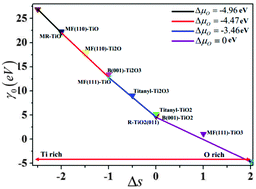The unexpectedly rich reconstructions of rutile TiO2(011)-(2 × 1) surface and the driving forces behind their formation: an ab initio evolutionary study†
Abstract
In this paper, we employ state-of-the-art theoretical approaches to elucidate the structures of the (011) surface of rutile (R-)TiO2. An unexpectedly rich chemistry has been uncovered. Titanyl-TiO2 and titanyl-Ti2O3 reconstructions can be used for rationalizing the experimental findings, matching the STM images and the changes in the band gap. From the viewpoint of thermodynamics, the predicted MF(111)-TiO reconstruction is more reasonable than the previously proposed MF(111)-TiO3 model, although there is a structural similarity. The richness of surface phases, the formation of which is driven by thermodynamic conditions and surface stress release, implies the multifunctionality of the R-TiO2(011) surface. After the clarification of TiO2(011) and TiO2(110) surface structures {PRL, 2014, 113, 266101} (the most important surfaces of rutile), the origin of the Brønsted acidity of R-TiO2, which has remained a mystery at the atomic level, can also be addressed in the near future.


 Please wait while we load your content...
Please wait while we load your content...